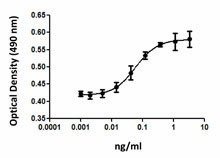- Regulatory Status
- RUO
- Other Names
- Interleukin 5

-

BCL-1 cell proliferation induced by mouse IL-5.
| Cat # | Size | Price | Quantity Check Availability | ||
|---|---|---|---|---|---|
| 581502 | 10 µg | $136.00 | |||
| 581504 | 25 µg | $223.00 | |||
| 581506 | 100 µg | $675.00 | |||
| 581508 | 500 µg | $1992.00 | |||
IL-5 is a homodimeric glycoprotein that was initially identified by its ability to support the in vitro growth and differentiation of mouse B cells and eosinophils. IL-5 induces eosinophil progenitor cell proliferation, terminal differentiation, and activation. In animal models of allergic diseases or helminth infection, IL-5 induces a massive proliferation of eosinophil progenitors in the bone marrow, promotes eosinophil recruitment with eotaxins, and prolongs eosinophil survival in local tissues. IL-5 regulates genes involved in the B cell terminal differentiation. IL-5 induces CD38-activated splenic B cells to differentiate into immunoglobulin M-secreting cells and go through m to g1 class switch recombination at the DNA level, resulting in immunoglobulin G1 (IgG1) production. IL-5 binds the IL-5R complex, which consists of an IL-5Rα chain specific for IL-5 and a common β-chain that is shared by the receptors for IL-3 and GM-CSF. The alpha subunit is required for ligand-specific binding whereas association with the beta subunit results in increased binding affinity. IL-5 plays important roles in the pathogenesis of asthma, hypereosinophilic syndromes, and eosinophil-dependent inflammatory disease.
Product Details
- Source
- Mouse IL-5, amino acids Met21-Gly133 (NM_010558.1), was expressed in insect cells.
- Molecular Mass
- The 113 amino acid recombinant protein has a predicted molecular mass of approximately 13.1 kD. The DTT-reduced protein migrates between 13 to 20 kD and the non-reduced protein at approximately 40 kD by SDS-PAGE. The N-terminal amino acid is Met.
- Purity
- >98%, as determined by Coomassie stained SDS-PAGE.
- Formulation
- 0.22 µm filtered protein solution is in PBS, pH 7.2.
- Endotoxin Level
- Less than 0.01 ng per µg cytokine as determined by the LAL method.
- Concentration
- 10 and 25 µg sizes are bottled at 200 µg/mL. 100 µg size and larger sizes are lot-specific and bottled at the concentration indicated on the vial. To obtain lot-specific concentration and expiration, please enter the lot number in our Certificate of Analysis online tool.
- Storage & Handling
- Unopened vial can be stored between 2°C and 8°C for up to 2 weeks, at -20°C for up to six months, or at -70°C or colder until the expiration date. For maximum results, quick spin vial prior to opening. The protein can be aliquoted and stored at -20°C or colder. Stock solutions can also be prepared at 50 - 100 µg/mL in appropriate sterile buffer, carrier protein such as 0.2 - 1% BSA or HSA can be added when preparing the stock solution. Aliquots can be stored between 2°C and 8°C for up to one week and stored at -20°C or colder for up to 3 months. Avoid repeated freeze/thaw cycles.
- Activity
- Bioactivity was measured by its property to stimulate the proliferation of BCL1 cells in a dose dependent manner. ED50 = 0.03 - 0.15 ng/ml, corresponding to a specific activity of 0.66 - 3.3 x 107 units/mg.
- Application
-
Bioassay
- Application Notes
-
BioLegend carrier-free recombinant proteins provided in liquid format are shipped on blue-ice. Our comparison testing data indicates that when handled and stored as recommended, the liquid format has equal or better stability and shelf-life compared to commercially available lyophilized proteins after reconstitution. Our liquid proteins are verified in-house to maintain activity after shipping on blue ice and are backed by our 100% satisfaction guarantee. If you have any concerns, contact us at tech@biolegend.com.
- Product Citations
-
Antigen Details
- Structure
- Homodimeric cytokine
- Distribution
-
Activated Th2 cells, mast cells, eosinophils, and basophils. In addition, newly identified IL-5 producing cells are: natural helper cells or nuocytes (lately identified as type II innate lymphoid cells), MPPtype2, and Ih2 cells.
- Function
- IL-5 regulates the production of eosinophils from purified hematopoieitic progenitors and regulates genes involved in the B cell terminal differentiation. IL-25 and IL-33 induce Th2 cytokines, among them IL-5.
- Interaction
- Eosinophils, B cells, basophils, and activated T cells.
- Ligand/Receptor
- Heterodimer IL-5Rα (CD125); β-subunit (CDw131) in common with IL-3R, GM-CSFR
- Cell Type
- Embryonic Stem Cells, Hematopoietic stem and progenitors
- Biology Area
- Cell Biology, Immunology, Signal Transduction, Stem Cells
- Molecular Family
- Cytokines/Chemokines
- Antigen References
-
1. Lopez AF, et al. 1988. J. Exp. Med. 167:219.
2. Horikawa K and Takatsu K, 2006. Immunology 118:497.
3. Moro, K, et al. 2010. Nature 463:540.
4. Neill, DR, et al. 2010. Nature 464:1367.
5. Saenz SA, et al. 2010. Nature 464:1362.
6. Ikutai M, et al. 2012. J. Immunol. 188:703.
7. Yazuda K, et al. 2012. P. Nat. Acad. Sci. USA 109:3451. - Gene ID
- 16191 View all products for this Gene ID
- UniProt
- View information about IL-5 on UniProt.org
